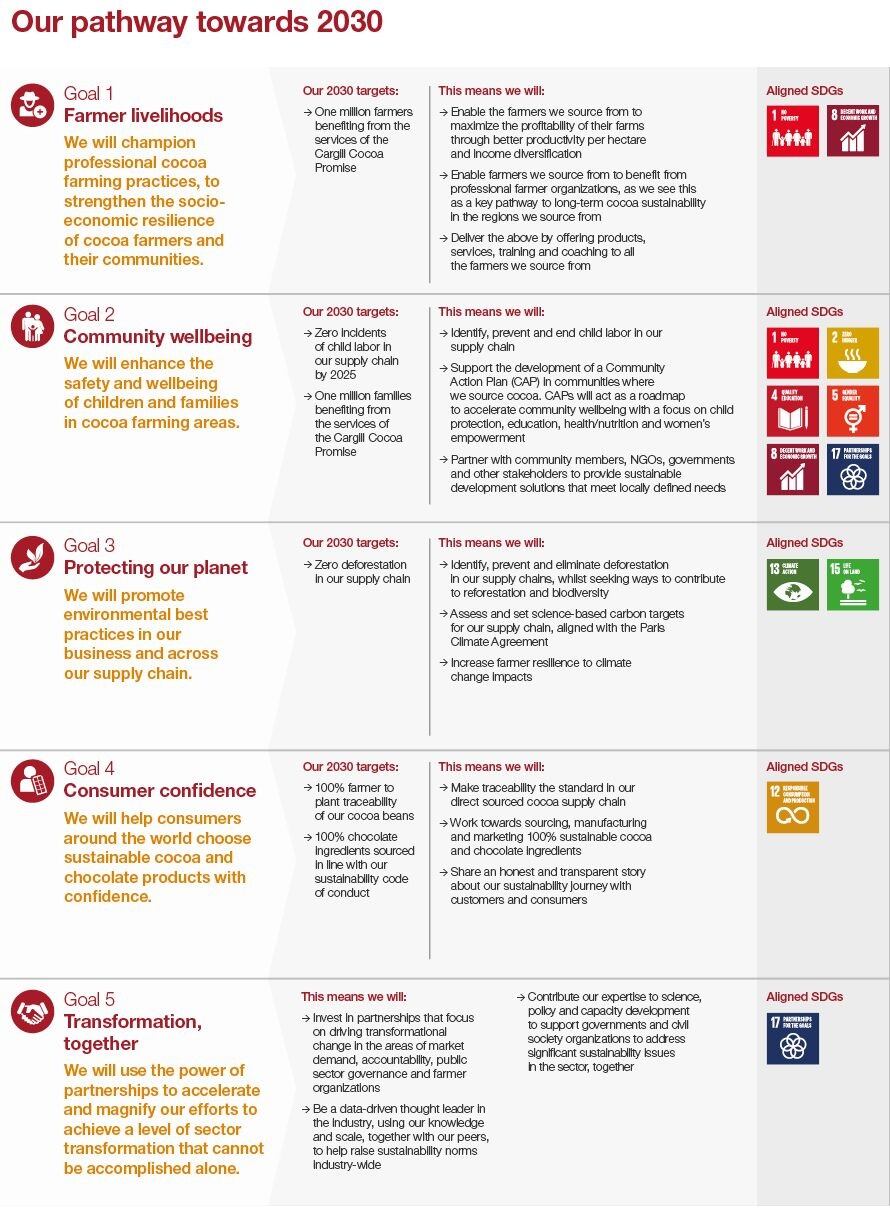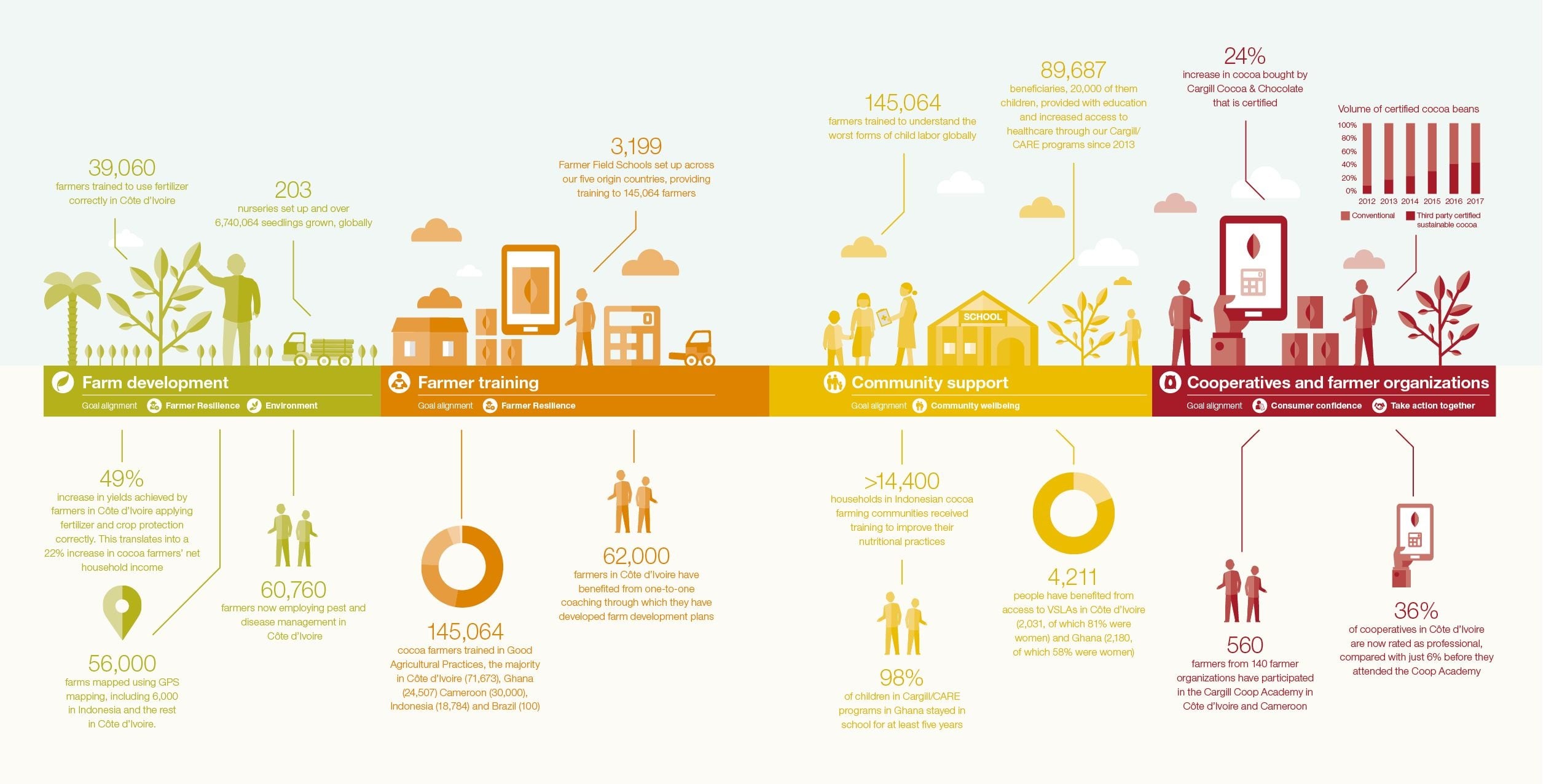The company has aligned its target with the 2030 UN Sustainable Development Goals (SDGs).
The world’s second largest commercial cocoa grinder has also committed to zero cocoa-driven deforestation by 2030 and zero child labor in its cocoa supply chain by 2025.
Cargill sources cocoa from around 400,000 farmers – mainly from smallholders with less than 10-hectare farms - across five countries.
Around 45% of its 2016/17 volumes are from what it calls sustainable certified sources from farmers who are part of its sustainability program The Cargill Cocoa Promise.
Code of conduct
The company’s 2030 goals are focused on five areas:
- Farmer Livelihoods (through productivity increases and income diversification)
- Community Wellbeing (including child labor prevention)
- Protecting our Planet (zero deforestation)
- Consumer Confidence (including full traceability)
- Transportation Together (public-private partnerships).
The graphic below gives more detail on what each area means.
A key component under the ‘Consumer Confidence’ pillar is for Cargill’s chocolate ingredients to meet its code of conduct by 2030.
“Various chocolate ingredients, such as sugar, dairy and other fats are likely to have different codes with regard to sustainability by 2030,” Taco Terheijden, director of cocoa sustainability at Cargill, told ConfectioneryNews.
Cocoa under the Promise
For cocoa, Cargill aims to source its entire cocoa needs from its sustainability program The Cargill Cocoa Promise by 2030.
“Ultimately, we anticipate a convergence of sustainability codes across cocoa sourcing companies, with potentially an independently verifiable code becoming the norm,” said Terheijden.

The Cargill Cocoa Promise – launched in 2012 – covers over a third of the company’s annual cocoa needs.
Cargill’s cocoa sustainability program runs in multiple origins, but its flagship program is in Côte D’Ivoire, where it buys around 17% to 20% of the annual crop.
During a visit to a Cargill factory in Côte D’Ivoire last year, Cargill said 72% of its annual Ivorian cocoa supply (200,000 to 250,000 metric tons) was third party certified: 60% by UTZ, and the rest from Fairtrade and Rainforest Alliance.
The Cargill Cocoa Promise in Côte D’Ivoire covers around 80,000 farmers across 114 cooperatives, who have average annual yields of 350 kg per hectare, Cargill told us last year.
“It is our aim to reach one million farmers by 2030 [globally under the Cocoa Promise], in line with an ambitious business growth plans for the future, in which direct sourcing plays a key role,” said Terheijden today.
Cargill competitor Barry Callebaut last year committed to fully sustainable cocoa to its definition by 2025.
Terheijden said Cargill’s target date was later as it matches the UN’s SDGs, as well as targets set by industry-led sustainability platform CocoaAction and the Cocoa and Forests Initiative.
‘A value the industry will pay for’
Will Cargill’s move to fully sustainable, traceable cocoa eliminate premiums customers pay for sustainable chocolate ingredients?
“Market demand will ultimately decide which products command a premium – and those which do not,” said Terheijden.
“If cocoa can be traced to farmers that are, for example, deforestation free and protected area infringement free, this could come at a premium versus cocoa that has only third party certification/verification. It is a ‘value’ the industry will pay for,” he said.
Improving farmer livelihoods
Cargill says it will support farmer livelihoods under its plan primarily by making farmers in its program business savvy professionals through training.
It will also provide inputs to promote productivity increases and income diversification.
Cargill has not committed to guaranteeing a living income.
“We focus on the capacity and knowledge of farmers, provide access to the input they need and provide them with the means to deal with the price fluctuations and generate a living income to their best ability,” said Terheijden.
“Through our farmer training, capacity building and engagement programs, we have partnered with more than 100,000 cocoa farmers so they can run successful farming businesses,” he continued.
Yield increases
Farmers under Cargill’s Cocoa Promise in 2016 achieved average yield increases of 49% in their first year.
“For the farmers with whom we collaborated, the average yield of 565 kg per hectare is higher than the average for cocoa farmers in Côte D’Ivoire,” said Terheijden.
Average yields for the 95% of cocoa grown by smallholders globally is below 500 kg per hectare, according to the International Cocoa Organization (ICCO).
Changes to income
But have farmers’ incomes improved as a result of the yield increases under Cargill’s Cocoa Plan?
Cargill does not report changes in income.
Terheijden said: “There are numerous shocks that impact the economic viability of cocoa farming, including short term weather events, longer term climate change related disturbances, pest and disease outbreaks.
“There is no disputing the fact that price is an integral component of farmer income. In years with a lower price, there will be a direct negative impact.”
He said supporting yield increases under the Cargill Cocoa Promise “helps mitigate the possible impact of falling prices on farmer incomes”.
Cocoa child labor
Cargill has pledged to have a child labor-free cocoa supply chain by 2025.
Earlier this year, a district court in California dismissed a 12-year lawsuit accusing Nestlé, ADM and Cargill of aiding and abetting child slavery in West Africa.
Around 2.03m children were found to be in hazardous work cocoa production in Côte D’Ivoire and Ghana during the 2013/14 harvest season, up 21% from 2008/09, according to a study by Tulane University.
Cargill this year collaborated with the International Cocoa Initiative to incorporate the non-profit’s Child Labor Monitoring & Remediation System (CLMRS) into the Cargill Cocoa Promise.
The CLRMS is being piloted across eight farmer cooperatives in Côte D’Ivoire reaching nearly 7,000 cocoa farming households and may eventually be scaled up throughout The Cargill Cocoa Promise.
“We will intensify our efforts to tackle child labor in our supply chain through the extension of the CLMRS to include a further nine new cooperatives in 2017/2018, reaching 8,000 more farmers,” said Cargill in a report this week.

Deforestation-free
Cargill already pledged zero deforestation across its agricultural supply chains by 2030 when it signed the New York Declaration on Forests in 2014.
This year, it was also one of the 12 cocoa and chocolate companies that first committed to the Cocoa & Forests Initiative to end cocoa supply chain deforestation.
Asked if Cargill will also move to 100% agroforestry systems and shade grown cocoa trees, Terheijden said: “…There is no common agreement that these are the best approaches in all circumstances.
“They may also not be beneficial to cocoa farmers, and may not be how national governments see their policies developing around land use.”
Cargill’s sustainable cocoa volumes
- Ghana - 4% sustainable sourced cocoa from Ghana in 2016/2017 (5% in 2012/2013)
- Brazil – 1% sustainable sourced cocoa from Brazil in 2016/2017 (0% in 2012/2013)
- Côte D’Ivoire - 59% sustainable sourced cocoa from Côte d’Ivoire in 2016/2017 (34% in 2012/2013)
- Indonesia - 7% sustainable sourced cocoa from Indonesia in 2016/2017 (0% in 2012/2013)
- Cameroon – sustainable sourced cocoa from Cameroon in 2016/2017 (0% in 2012/2013)
Direct sourcing
A fully traceable cocoa supply by 2030 is key to combatting deforestation, says Cargill.
The supplier is aiming to reduce complexity in its cocoa supply chain by moving to direct sourcing. Around 85% of its sustainable cocoa is sourced directly.
“We already source close to 99% of beans directly from cooperatives in Côte D’Ivoire, which will form the basis for our ability to trace cocoa to farm level via the cooperatives,” said Terheijden.
“Our Licensed Buying Company (LBC) in Ghana is another area where we are building traceability capabilities as all beans sourced through the LBC are traceable to the farmer.
“It is also anticipated that third party certification/verification will continue to play a role in ensuring traceability, and we are mapping all farms in our direct supply chain,” he said.
GPS mapping for traceability
Cargill said it will invest in technology to realize full traceability such as in GPS mapping, digital data collection and mobile money.
It has already used GPS mapping to map over 50,000 farms in Côte D’Ivoire, 6,000 in Indonesia, and hundreds in Cameroon.
Next it will use GPS mapping to determine if a farm is linked to a deforestation hotspots and will assess farm sizes across 36,000 more farms in Côte D’Ivoire, as well as extending mapping to Ghana and Brazil in 2018.
Cargill says it will double the number of farms mapped using GPS technology to 100,000 globally by 2020.
In Ghana, Cocoa Promise farmers deliver their cocoa to community warehouses where beans are digitally weighed and assigned a fully traceable bar code before funds are transferred to the farmer’s phone or e-wallet using e-money.
